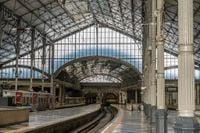Two centuries ago, a modest but momentous event unfolded in the northeast of England that would forever alter the way people, goods, and ideas moved across the globe. On September 27, 1825, George Stephenson’s pioneering steam locomotive, Locomotion No. 1, embarked on its inaugural 26-mile journey along the Stockton & Darlington Railway, carrying coal, flour, and a handful of intrepid passengers between Shildon and Stockton, via Darlington. This was no mere technical feat—it was the birth of the modern railway, a transformation that would ripple out from Britain to shape the very fabric of the industrial age.
Fast forward to 2025, and the United Kingdom is alive with celebrations marking the bicentenary of this world-changing journey. According to the Associated Press, railway enthusiasts, local communities, and history buffs have been gathering at dozens of locations throughout the year, but the highlight has undoubtedly been a recreation of that historic trip on sections of the original line. A newly restored replica of Locomotion No. 1 chugged along the same route, drawing thousands of spectators eager to witness a living slice of history. Prince Edward, the youngest brother of King Charles III, was among the passengers on a carriage pulled by the replica engine, underscoring the national significance of the occasion.
Doug Haynes, an 81-year-old retired aircraft engineer, made the 100-mile trek to Shildon just to see the re-enactment. Reflecting the excitement of the crowd, Haynes told the Associated Press, "It was tremendous. The work that they have put in to make this happen has been well worthwhile. It was well worth the trip over for me." Such sentiments echo the joy and awe that filled the air two centuries ago, when onlookers—including newspaper reporters—traveled from all over Britain to catch a glimpse of the steam-powered marvel. Back then, Darlington even declared a holiday in honor of the event.
The Stockton & Darlington Railway was not the first railway in Britain, but it was the first to incorporate the standard-gauge, steam-hauled features that would become the blueprint for railways worldwide. As reported by Devdiscourse, the original run marked a nautical milestone, setting the stage for modern rail travel and launching Britain’s journey as a global industrial leader. The ripple effects were profound: railways enabled the rapid movement of raw materials, like coal and iron ore, fueling the industrial revolution and accelerating urbanization. Social life was transformed, too, as trains freed up time for leisure and opened up the countryside to tourism and the rising middle class. In the words of one attendee, Louise Jones, "It was amazing to see it moving. My dad used to work on the railways. This was a once-in-a-lifetime opportunity to see what it would have looked like 200 years ago."
Britain’s reputation as the cradle of train travel endures, even as other countries have developed larger and faster networks. Throughout 2025, as reported by The West Australian, bicentenary celebrations have taken place up and down the country. The original Stockton & Darlington route, now a significant part of the Tees Valley Line, continues to link towns around Middlesbrough, in a region renowned for its scenic train journeys. Railways that once served industry now double as heritage attractions, drawing visitors from across the world.
Among these, the North Yorkshire Moors Railway stands out—a volunteer-run, 39-kilometer line that winds through heather-clad moorland between Pickering and the seaside town of Whitby. This heritage railway, with its lovingly restored stations, vintage carriages, and ticket inspectors in period attire, offers a nostalgic glimpse into the golden age of steam. Passengers can hop on and off at stations like Goathland, famous as a filming location for the TV drama Heartbeat, or simply soak in the landscape from their window seats.
Another jewel in Britain’s railway crown is the Settle-Carlisle line, a 117-kilometer stretch built in the 1870s to rival existing routes connecting England and Scotland. Its construction involved the labor of around 6,000 mostly Irish navvies and resulted in a series of engineering marvels, including 14 tunnels and more than 20 viaducts. The poster child of the line is the Ribblehead Viaduct—a 400-meter, 24-arched structure that soars above boggy ground. While often mistaken for the viaduct featured in the Harry Potter films (that honor goes to Scotland’s Glenfinnan Viaduct), Ribblehead has had its own share of screen time, inspiring the TV period drama Jericho.
Travelers on the Settle-Carlisle line can alight at Ribblehead Station, explore the visitor center and café, or even tackle a hike up Whernside, Yorkshire’s highest summit. The line, which was threatened with closure in the late 1980s due to declining freight and passenger numbers, was famously saved from the axe by then-transport minister Michael Portillo. According to The West Australian, Portillo—once known for his tough stance on loss-making industries—has since called saving the line his greatest political achievement. Since its restoration, the Settle-Carlisle route has enjoyed a renewed popularity, featured in documentaries and drawing rail fans from near and far.
The ongoing celebrations are about more than nostalgia. They’re a testament to the enduring power of railways to connect people and places, to inspire wonder, and to drive economic and social change. The bicentenary has shone a spotlight on Britain’s railway heritage, encouraging locals and tourists alike to rediscover the joys of train travel—whether by riding a steam-hauled service through the Yorkshire Dales or simply pausing to admire the Victorian charm of a country station.
For those eager to experience these storied lines firsthand, tickets and timetables for the North Yorkshire Moors Railway and the Settle-Carlisle line are readily available online, with regular services linking picturesque towns and offering photo opportunities at iconic sites like the Ribblehead Viaduct. The region’s railways have not only survived—they’ve thrived, becoming symbols of resilience and ingenuity.
As Britain marks 200 years since the dawn of the modern railway, the legacy of George Stephenson’s Locomotion No. 1 lives on—not just in museums or on commemorative journeys, but in the continued romance and relevance of train travel itself. For many, the celebrations are a chance to reflect on how a single journey in 1825 set the wheels of progress in motion, shaping the country’s destiny and, in many ways, the world’s.


